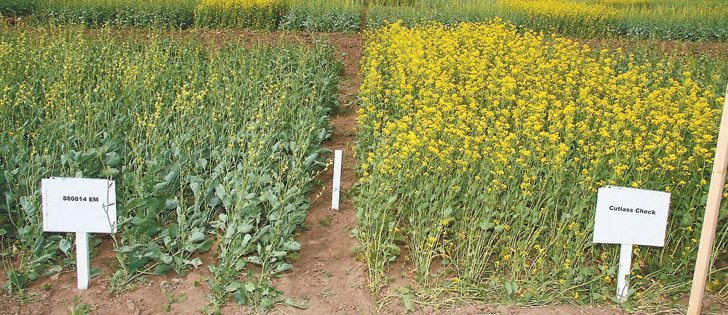Operation has evolved | Tough years led to business savvy and cattle breeding success for Davidsons
PONTEIX, Sask. — In one way, Vernon and Eileen Davidson didn’t go far.
The successful Gelbvieh breeders live just kilometres from where they grew up south of Ponteix, Sask. They married young, at 18, and moved to their existing home 35 years ago.
But in other ways they have moved light years.
Their ranch has evolved from a farming and small commercial cattle operation of 50 head to a purebred business of 250 cows that reaches worldwide.
Earlier this month, the Davidsons were again in Denver, Colo., at the National Western Stock Show showcasing their cattle.
Read Also

Nutritious pork packed with vitamins, essential minerals
Recipes for pork
They have attended 23 of the last 24 shows and experienced their greatest success last year when DVE Davidson Romance 116W, a yearling bull, was named reserve national champion.
In 2009, another yearling, Powerhouse 13U, was voted the top young Gelbvieh in the Breeder’s Choice Bull Futurity at Denver.
This year, they showed the reserve junior bull, Jumpstart 44X.
Their success at Canadian shows such as Farmfair International and Canadian Western Agribition has been well noted. They also support their local Swift Current show at Frontier Days.
Their home is full of banners that prove decisions made in the 1980s were the right ones.
Beef stabilization was in place then, and they bought some feeder steers under the program.
“I noticed the Gelbvieh influence outsmoked everything in the pen,” said Vern.
They bought their first purebred cow in 1985.
Then, drought struck.
“We didn’t even breed her,” Eileen said.
They kept the cow and a dozen heifers but turned briefly to sheep that spring. Although that drought-influenced decision made them money, it was the only sheep breeding season at their farm.
“Raising cattle was much more appealing,” Eileen said.
They now breed 250 cows each year and cull back to 210. Calving begins in February.
They seed enough land to grow feed.
“A lot of the farmland that we bought we seeded back down,” Vern said.
The Davidson ranch is located in a part of the province many believe should never have been farmed in the first place. Drought is a never-ending concern and the family has struggled through two significant events: 1986-87 and 2003-09.
The last drought coincided with the discovery of BSE in Canada and forced them to reduce their numbers to struggle through.
“It probably made us better businesspeople,” Eileen said.
Vern agreed, saying they had to get inventive with feed supplies during the drought to keep rations balanced. He remembers taking just 16 bales of greenfeed off a half-section of drought-stunted crop.
“We were never to the point we didn’t have pasture,” he said. “We never had to run to the max. But we bought a lot of feed.”
He also said luck played a big part in their survival.
“A little faith didn’t hurt, either,” Eileen added.
Both were vocal in speaking out for area producers as part of the loosely knit Southwest Drought Committee that lobbied for assistance during the mid-2000s.
The lobby was at least partly responsible for the Farm and Ranch Water Infrastructure Program the provincial government introduced in 2008.
The Davidsons were set up with good drinking water for themselves, thanks to wells, but getting water to cattle, particularly during a drought, was another proposition.
The FRWIP program helped producers and communities develop wells and pipelines.
Tapping into the Gravelbourg aquifer at the north end of their land, the Davidsons were able to install four kilometres of pipeline in 2008, and the same amount again the following year.
Water bowls are located throughout their pastures.
They also left their old wells on line as a precautionary measure.
The water system was a necessity, said Eileen. It adds value to their property and ensures viability.
However, others in the area weren’t able to take advantage of the program.
“A lot of people were right out of money,” said Vern.
The drought was one reason for that. BSE was another.
The Davidsons weathered the storm by not borrowing money against their cows and keeping their cow herd young.
They have always used that strategy, and Vern said the average age of their cows is just 4.2 years.
Eileen said the bulls go out May 1, are pulled in July and the cows are pregnancy checked in September.
“Anything open goes to town,” she said.
Vern said their goal is to produce quality, reputable cattle that people want. Years of selection have helped them accomplish this, and the couple was determined not to let BSE derail those plans.
“We run a pretty high standard program,” he said. “We’re not out to sell just one high priced bull.”
The Davidsons will host their 23rd annual bull sale in March, in conjunction with Lonesome Dove Ranch, which is operated by their son, Ross, and his wife, Tara.
The two ranches host an open house and heifer sale in July.
Davidson Gelbvieh genetics can be found worldwide, thanks to embryo sales. Mexican buyers arrived at the March bull sale two years ago and took four animals home.
The couple has also participated in a Farmfair mission to Mexico as part of a breed improvement program in that country, and has travelled Canada and the world to judge cattle.
They did all this while raising daughter Carla, and sons Glen, Ross and Tyler, and volunteering with 4-H, their breed association and the Saskatchewan Stock Growers Association.
“I don’t know how we actually did that,” Vern said with a laugh.
They now enjoy six grandchildren.
They are also still enjoying their lifestyle and chosen business.
“We believe in what we’re doing,” Eileen said.

















